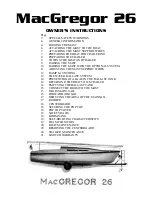
2014 World Cat 290DC Owners Manual
4.10.4 Reporting Accidents
Federal regulations require that operators involved in an accident file a written account of the situation within 48
hours. Reports should be submitted to the State Boating Law Administrator. You can obtain forms through the USCG
or local authorities (i.e. harbor patrol, sheriff or police offices). In the event that a casualty or disappearance occurs as
the result of an accident, you must notify the authorities immediately by phone or radio and fill out a written statement.
4.10.5 Weather
Pay attention to weather patterns. If you find yourself in the path of a storm, seek shelter immediately. If you cannot
reach a dock, seek refuge inside the boat while the storm advances. Never get in the water, and stay clear of metal
components on your boat. If lightning strikes, it would likely pass through metal objects seeking a ground.
4.10.6 Towing
Due to an accident or loss of power, it may become necessary to tow another vessel or have your boat towed. If you
are providing assistance, never attempt to tow a boat larger than your own. Be certain to use proper lines (ropes) and
rational judgement to prevent further damage. Tow lines are under heavy strain, therefore passengers should remain
clear of the lines to protect themselves from injury. For more information on towing, reference page 39 of the
Sportfish, Cruisers, Yachts Owner’s Manual.
4.11 C
ARBON
M
ONOXIDE
(CO)
Page 4-18
!
!
!
!
!
!
D
D
A
A
N
N
G
G
E
E
R
R
Carbon Monoxide (CO) is a colorless, odorless, and tasteless gas produced by the exhaust system of any
combustible engine. CO can cause brain damage or death, if inhaled over an extended period of time. To
protect yourself and your passengers, never block the ventilation outlets in cabins, consoles, or other
enclosed spaces.
One of the most important considerations when dealing with boating safety is carbon monoxide. Commonly referred to
as (CO), carbon monoxide is a colorless, odorless, and tasteless gas emitted from any engine exhaust. Including
inboards and outboards. A CO particle is close in weight to the air we consume; therefore it does not rise or fall in the
atmosphere, but accumulates in enclosed spaces. Boat owners with enclosed heads, cabins, or canvas enclosures should
pay particular attention to CO. Be aware that fumes produced on your boat can affect other vessels and other boats can
affect you. A primary concern is the use of generators when boats are moored adjacent to each other.
Carbon Monoxide is poisonous and potentially fatal if inhaled over an extended period of time. Symptoms of CO
poisoning include:
•
Dizziness
•
Nausea / Vomiting
•
Headache / Throbbing in the temples
•
Fatigue
•
Muscular twitching
•
Inability to focus or think clearly
If you or any of passengers experience any of these symptoms, leave the area and find a source of fresh air imme-
diately. If your symptoms persist, seek medical attention.
Summary of Contents for 2014 290DC
Page 1: ...2014 OWNER S MANUAL 290DC ...
Page 11: ...2014 World Cat 290DC Owners Manual 3 2 STANDARD EQUIPMENT ON ALL WORLD CATS Page 3 11 ...
Page 12: ...2014 World Cat 290DC Owners Manual 3 3 290DC OPTIONS LIST Page 3 12 ...
Page 33: ...2014 World Cat 290DC Owners Manual 6 10 TRADITIONAL ROCKER SWITCH DIAGRAM Page 6 33 ...
Page 42: ...2014 World Cat 290DC Owners Manual Page 7 42 ...
Page 43: ...2014 World Cat 290DC Owners Manual Page 7 43 ...
Page 44: ...2014 World Cat 290DC Owners Manual Page 7 44 ...
Page 45: ...2014 World Cat 290DC Owners Manual Page 7 45 ...
Page 47: ...2014 World Cat 290DC Owners Manual Chapter 8 HURRICANE PREPAREDNESS Page 8 47 ...
Page 48: ...2014 World Cat 290DC Owners Manual Page 8 48 ...
Page 49: ...2014 World Cat 290DC Owners Manual Page 8 49 ...
















































